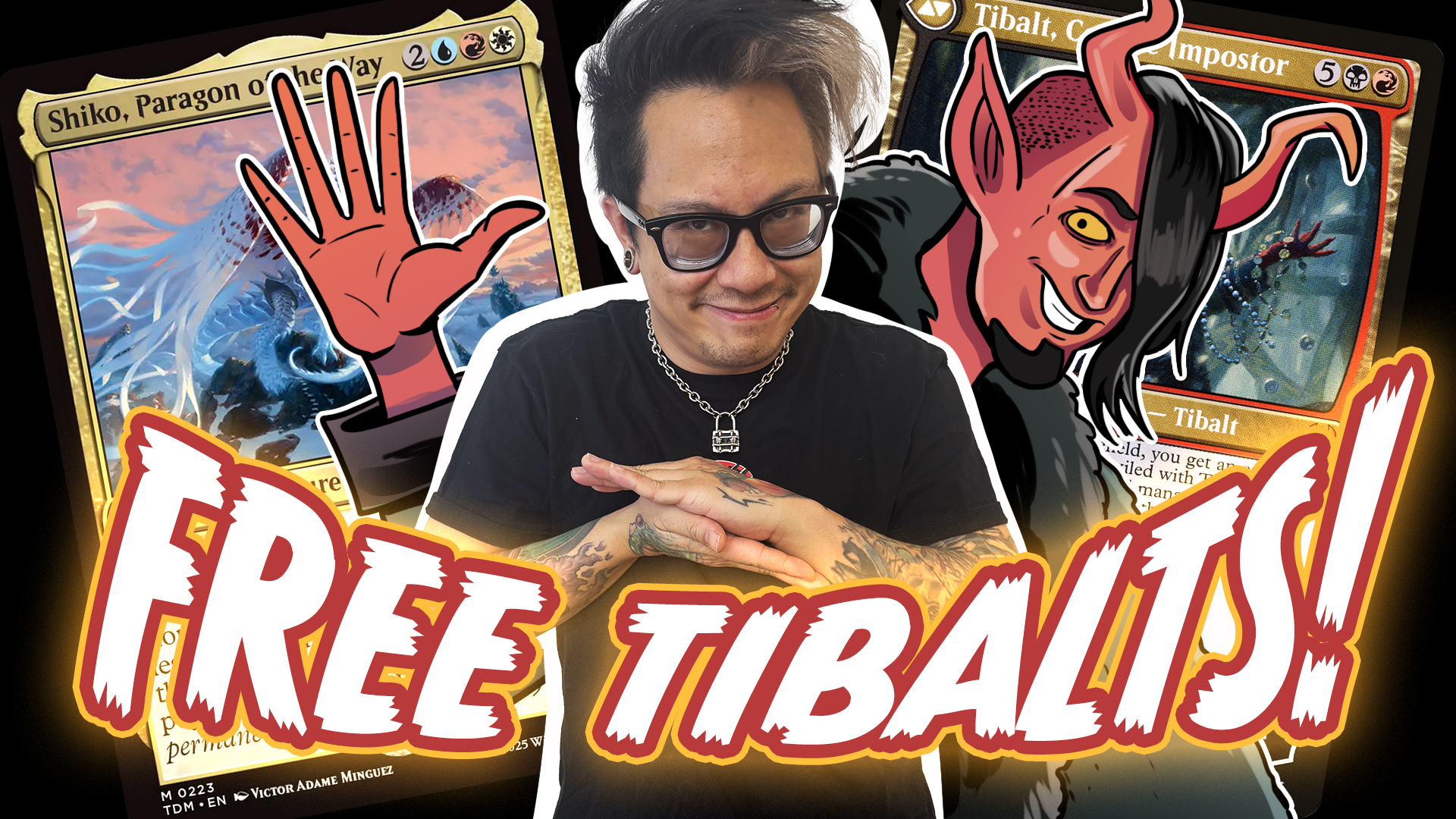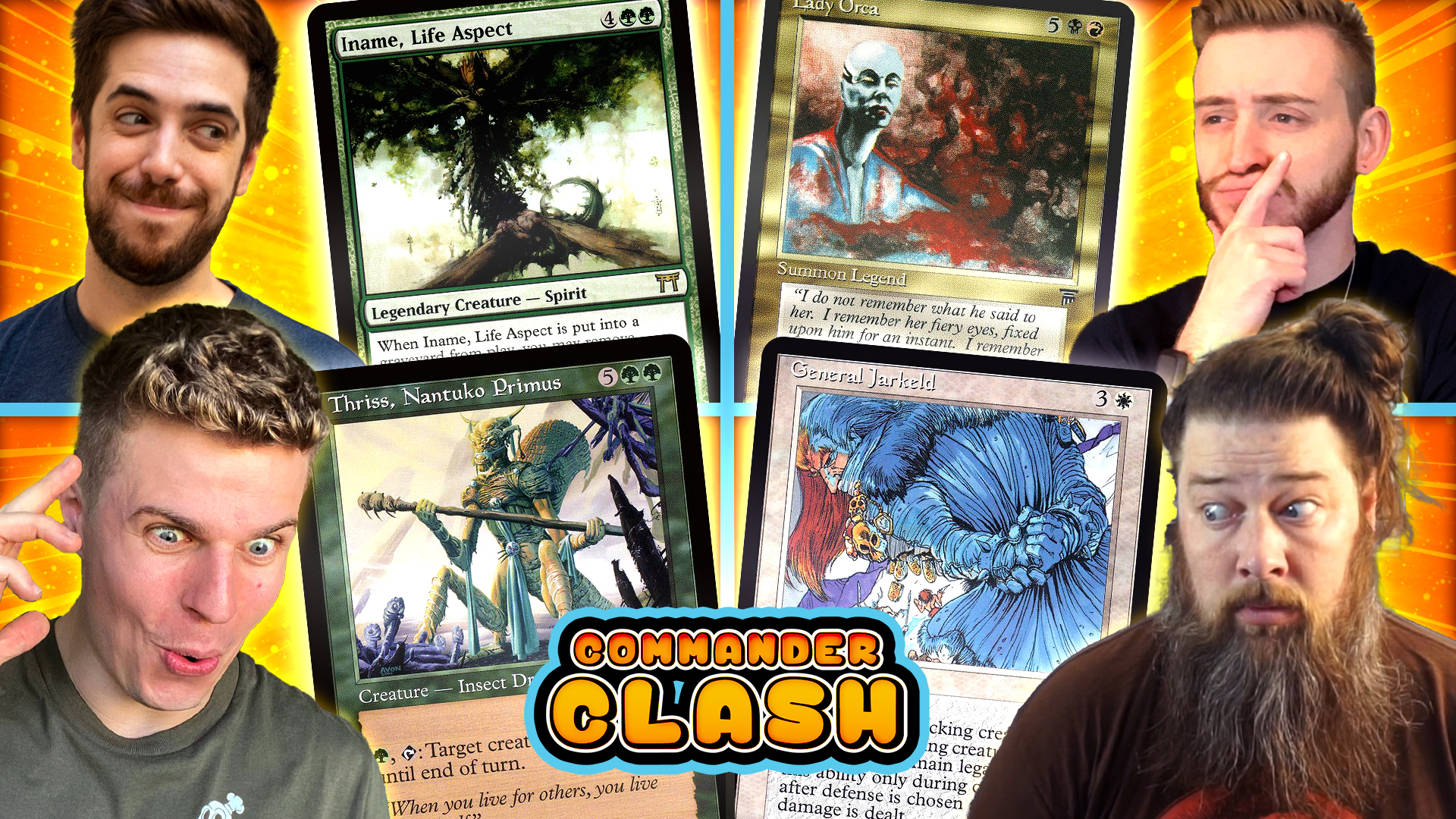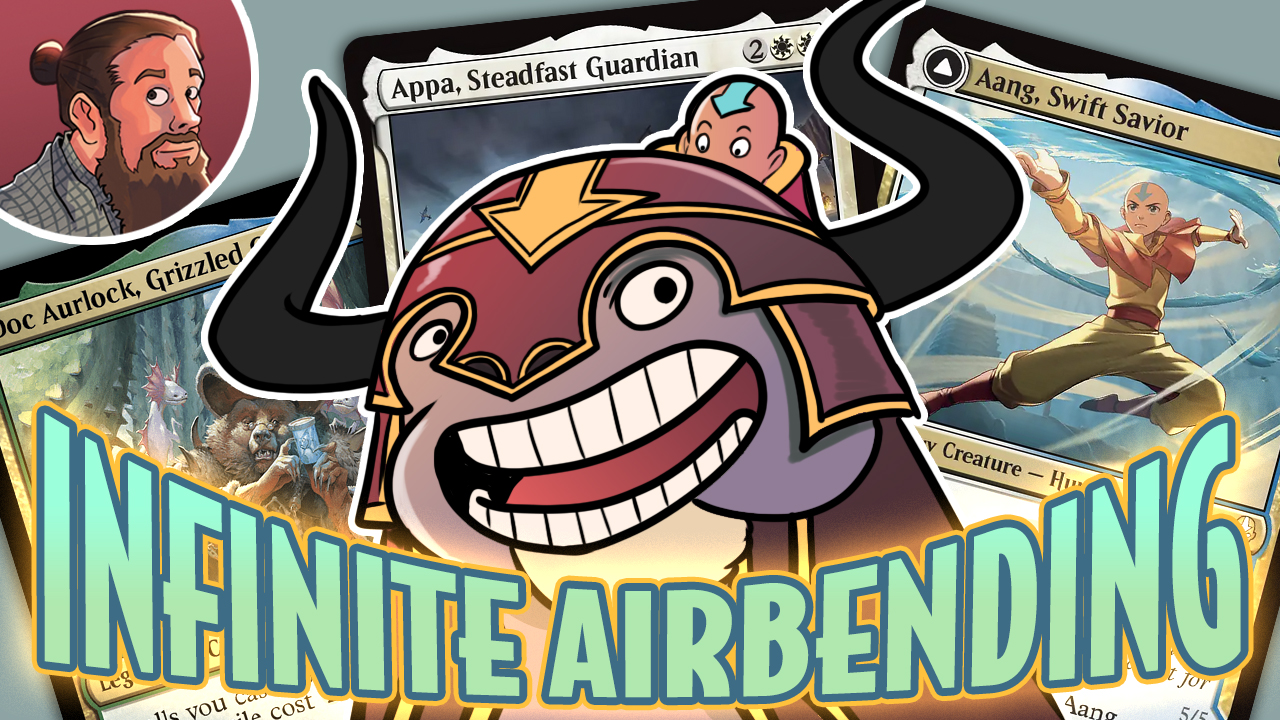Preparing for Rotation: Theros
One of the most important aspects of MTG finance is managing your collection — this is especially important for Standard cards approaching rotation. Not only can you save yourself a lot of money by selling cards before they rotate, you can also make money by buying certain cards as they decrease in price heading into rotation. To be fair, if your goal is to get the absolute highest price possible for your rotating staples, the best time to sell is in the winter when prices peak, but you can still save yourself some money by selling now rather than waiting until September. Likewise, the best time to buy cards that are rotating, especially non-staples (casual cards), isn't after rotation but over the summer heading into the rotation, so this window is just about to open (for eternal playables the Winter after rotation is typically the floor).
With the release of Battle for Zendikar this fall, four sets will rotate from Standard: Theros, Born of the Gods, Journey into Nyx, and Magic 2015. Over the next few weeks we will be breaking down these sets by talking about which cards to sell, which cards to hold, and which cards to buy. Of course if you are still using some of these cards you don't have to run out and sell them right away, although you should be aware that you will be losing some value by keeping them through rotation.
Sell
These are cards that I would have sold yesterday, but since we have yet to figure out a safe way of traveling back in time, selling them ASAP is the best we can do. Most cards from Magic sets generate their primary demand from Standard; when they rotate their supply increases (as Standard-only players sell off their copies) and demand drops which causes prices to decrease dramatically. Selling these cards before they lose most of their value is one of the keys to maintaining a Magic collection and (when operating on a budget) having some money sitting around to buy cards for the next Standard season.
Stormbreath Dragon
The upside of Stormbreath Dragon is that it is a mythic and a member of Magic's most popular tribe (dragons). The downside is that its playability in Modern is severely limited by the presence of Thundermaw Hellkite. Although Stormbreath Dragon might be the better of the two in a specific metagame or in a specific deck, generally speaking Thundermaw Hellkite is just a more powerful card offering a faster clock and the ability to wipe out a board of Lingering Souls tokens. Both are on the more spikey end of the dragon spectrum, so I would expect their demand from casual players to be relatively low.
The bigger issue is that Thundermaw Hellkite isn't even a $10 card at the moment, and this is despite the fact that it is from a lower-supply set and sees more (although admittedly fringe) play in Modern. I can't see Stormbreath Dragon falling all the way to bulk mythic status, but ending up at half of its current price (maybe in the $6 range) certainly isn't out of the question. While it could slowly gain over the long term, you're still better off selling now and buying in later — potentially this winter, when Stormbreath Dragon should hit its post-rotation low.
Standard-Only Rares



Both Hero's Downfall and Fleecemane Lion are the very definition of Standard-only staples that simply don't have much demand in other competitive formats and are lacking in casual appeal. Hero's Downfall is just too slow for Modern and Legacy and is overshadowed by more flexiable options at the same CMC (Maelstrom Pulse in Modern and Vindicate in Legacy). Fleecemane Lion is basically a Watchwolf; it dies to Lightning Bolt and getting it killed in response to a monstrous activation is potentially a game losing tempo swing. Tarmogoyf formats are simply not the place for a seven-mana 4/4, even if it is indestructible and hexproof (i.e. it sill dies to [[Liliana of the Veil]). I expect them both to follow Loxodon Smiter, Dreadbore, and Pack Rat down into the $1 to $2 price range.
Whip of Erebos, on the other hand, seems like a pretty sweet casual card, but considering it has the clash pack printing, its current price is just too high to have that much appeal as a spec target. If it falls below much below a dollar there might be potential, especially for the clash pack foil, although it certainly could be reprinted in just about any supplemental product. I'm taking a wait and see attitude on this one, but if you can out them for anywhere near retail prices, I'm selling now.
Sylvan Caryatid, Masters of Waves, and Anger of the Gods


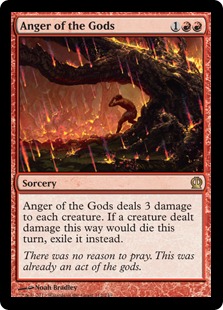
This group is separate from the Standard-only rares based on the fact that they actually see some amount of play in Modern. As a result I like them all a lot for the long term, but not really enough to hold them through rotation (assuming you can sell them for a decent price now).
I expect all three cards to lose about half of their value over the next several months, putting Sylvan Caryatid and Master of Waves in the $2-$3 range and dropping Anger of the Gods down to a little under $1. Once this happens all three are pretty appealing, especially Master of Waves which is an auto three- or four-of in Modern Merfolk (and pretty hard to reprint due to the devotion mechanic) and Anger of the Gods, which deals with all kinds of problematic creatures in Modern.
The issue with Sylvan Caryatid is that its generic name and lack of a set-specific mechanic or flavor makes it easy to reprint just about anywhere. It really feels like a Core Set rare. Even worse, its power level is lacking in Modern where Liliana of the Veil is a thing and blocking a 2-power creature isn't all that exciting. Being able to dodge Lightning Bolt and Path to Exile is nice, but it's not really worth an extra mana compared to Noble Hierarch or Birds of Paradise. That said, I could still see it increasing in price over the long-term, but I'm far less sure on this one.
Holds
Holds are cards that I'm not actively buying or selling at the moment (although if someone offers me SCG prices I might take it or if someone is willing to sell at-or-below buylist I might be interested in buying). There are two types of cards that I end up in this category. The first are cards that I don't expect to lose much at rotation, but I also don't expect to increase significantly in price in the near future. If you think you might want these for casual play, you might as well hold onto them through rotation because there isn't much to be gained or lost either way. The second type of card has low-loss potential but also the potential for significant gains. The reason these cards are not in the "buy" category is that their absolute low-point should be this Winter, so if you are buying on speculation, that would be the time to do so. The buy/sell spread means you are unlikely to make a profit by selling your copies now and repurchasing in the future.
The Gods





Personally I have no idea what to make of the god cycle over the short term. Apparently they are all heavily played in EDH, which is a good thing over the long term, but as far as tournament play, their options are limited. Thassa, God of the Sea is certainly the most Modern playable of the cycle thanks to her low converted mana cost and natural synergy in Merfolk builds, but even here she often doesn't make the 75. Heliod, God of the Sun occasionally pops up in white prison/devotion builds, which while fun, are far from tier one decks at this point. Purphoros, God of the Forge seems like it could have combo potential, but it has never lived up to the hype surrounding its release. The other two are basically relegated to kitchen tables.
It's possible that the gods don't drop too much in price for two reasons. First, most of the cycle is already relatively cheap and it's hard to imagine unique mythics that are casual favorites to drop to bulk prices. Second, most of these cards never had significant Standard demand, so their current prices are more reflective of their casual demand rather than some inflated Standard demand that will go away with rotation.
Over the long-term I think their future is bright; not quite Eldrazi bright, but I wouldn't be surprised if most of the cycle is $10+ before their next reprinting. Speaking of reprintings, their potential landing spots are somewhat limited. They could end up like the Praetor cycles from New Phyrexia — too valuable to put in Duel Decks or commander products, but not exciting/valuable enough to reprint the entire cycle in a Modern Masters. While there might be some merit to buying the cheaper members of the cycle over the summer, I don't think you risk too much by waiting a few more months. Once they hit the $2-$4 range they become very tempting and if any drop down below $1.50 it's pretty much a slam dunk.
The Planeswalkers


I lumped all three planeswalkers together, but in all honesty Elspeth, Sun's Champion is more on the "sell" side of the "hold" group (thanks in large part to the Duel Deck printing) while Xenagos, the Reveler is a more solid hold.
For planeswalkers without a Duel Deck printing, $5 is typically the long-term floor. For instance, Chandra Nalaar is generally considered to be among the worst planeswalkers and has been printed multiple times, but still manages to retail for $5 today. Duel Deck planeswalkers, on the other hand, sometimes dip a bit lower (for instance, Jace, Architect of Thought), but still typically end up at least $3. Of course, the one exception to this is Tibalt, the Fiend-Blooded, but the devil walker was a whole new kind of bad, and both Elspeth, Sun's Champion and Xenagos, the Reveler are far more playable and popular.
Overall, I expect Elspeth, Sun's Champion to lose another couple dollars down to $4 or $5, but not enough to really make her worth selling, while Xenagos, the Reveler should more or less maintain his current price through rotation.
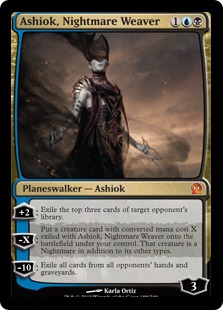
As for Ashiok, Nightmare Weaver, I almost listed him as a buy. I really like his long-term potential as a 3-cmc, one-printing planeswalker that is already seeing a bit of play in Modern. At the same time, the spread is currently weak which means vendors don't have much faith in selling their copies at the current price point. I expect his price to fall close to $5 after rotation, at which point picking up some copies has a definite appeal. A trajectory like Tezzeret, Agent of Bolas (except with less Legacy play and more Modern play) isn't out of the question.
Thoughtseize
In trying to figure out the future of Thoughtseize, I headed over to the list of the most played cards in Modern to see how some other recent eternal staples reacted to rotation. Considering that Thoughtseize is currently the sixth most played card in Modern, the most comparable cards seem to be Snapcaster Mage (3rd most played), Scavenging Ooze (9th most played) and Abrupt Decay (16th most played). All of these cards were Standard staples (which is why a card like Stony Silence isn't a good comparison even though it is 29th on the most played list; its price was always driven by eternal demand) and all of them are rares (which is why Liliana of the Veil (38th) and Delver of Secrets (26th) were not included).
Snapcaster Mage barely moved at rotation. While he peaked at $27 a few months after Innistrad was released, his Standard-legal price bounced between $20 and $25 for the next year-and-a-half. He was $21 at rotation and fell to a low of $19 the January after rotation before beginning to rebound. He hit $30 about six months post-rotation and last week he pushed past $60. Scavenging Ooze, on the other hand, hasn't put up any huge gains post rotation (likely the result of having three printings if you count both the original Commander decks, the DotP promo, and Magic 2014) but it hasn't really lost anything since rotation either. The green two-drop was $7 the April after its release and $5.50 today. Similar to Snapcaster Magic, Abrupt Decay hit its all-time low the January post rotation, falling from its $9 Standard-legal price to $6.50. By the next spring it had doubled up to $13 and in recent weeks has started to climb again with $20 by the end of the year being likely.
Perhaps the best thing about owning Thoughtseize is that it is basically impossible for a "strictly better" card to be printed. Its popularity might rise and fall based on the metagame (as we saw in Treasure Cruise Modern), but it will always be the best one-mana discard spell and it will always be powerful. This makes Thoughtseize a very safe place to be.
All in all, this suggests that selling Thoughtseize isn't a very good idea and it might even be the right time to buy your set if you don't have them already. They might get a tiny bit cheaper this January (but perhaps not, considering the February Pro Tour is Modern), but probably only by a few dollars. Either way, you shouldn't lose very much holding through rotation and barring a surprisingly early reprint, Thoughtseize should start creeping up towards $40 over the next few years.
Scrylands





Currently, all five of the Theros scrylands cost between $1 and $3, although you'll have difficulty selling them for much more than $1 given that the spread is fairly weak. While their peak prices were not incredibly high (typically between $4 and $5), this cycle has already lost half of its value and some of the most expensive in the cycle (especially Temple of Deceit/Temple of Silence) could still lose a bit more.
At the same time, I see all of the Theros scrylands as solid holds through rotation. If you look back through the recent history of rare dual lands, a dollar or two is pretty much the floor. The core set buddy lands have been reprinted about a million times and are basically the same price as the scrylands. They seem like an auto-include in any EDH deck, and while casual players might not appreciate the power of scrying as much as competitive players, a dual land is a dual land. Plus some members of the cycle see (very) fringe play in Modern, which certainly isn't a bad thing for their future price.
If you can out them for full retail today, it might be worth it — I wouldn't be surprised to see them in the $1 range over the fall, but all things considered I'm not to worried about holding on to any of these, unless they are reprinted in Commander this November, they are already near low-point.
Buys
Cards listed in this category are ones that I think may be worth buying now, or at very least over the summer when rotating casual cards typically hit their floor. As I mentioned before, some of the cards listed as "holds" have long term potential, but the best time to buy them will likely be six or eight months from now rather than over the summer.
Ashen Rider

It wasn't that long ago that Angel of Despair was a $5 card and even today (after a Commander reprinting) she manages to hold at about $4. Disregarding creature types (where angels are more popular than archons), Ashen Rider is almost always better than Angel of Despair. Exiling rather than destroying and having the potential to trigger twice is definitely worth one additional mana when you are playing EDH or casually.
The main appeal here is that Ashen Rider is basically a bulk mythic at the moment. If you buy copies at a dollar, how much can you realistically lose? Maybe $0.25 each? On the other hand, it's not impossible or even unlikely that this card ends up at four or five dollars in a couple years. The nightmare scenario is that you buy a bunch of copies and it ends up in this November's iteration of Commander, but even then, you aren't risking much for the potential reward if it manages to avoid the reprint bug for a while.
Rageblood Shaman, Pyxis of Pandemonium and Gift of Immortality



Personally I love specing on bulk rares simply because you only need to hit on 20 percent to make money. The risk is extremely low because in the worst case you can always bulk them out for $0.10 or $0.12 to buylists and even more if you put some work into it. Out of all the bulk rares in Theros, I think these three have the most potential.
Rageblood Shaman is a lord, which are always popular among casuals. Being a Minotaur is both a blessing and a curse. One one hand the tribe isn't all that popular (especially compared to casual favorites like elves, goblins, and dragons), although it does have a bit of a cult following. On the other hand, this lack of popularity makes it less likely we see Rageblood Shaman show up in a supplemental product (Duel Decks: Minotaur vs Homarid anyone?), which in theory gives it more time to increase in price.
Pyxis of Pandemonium is sort of a long-shot, but the effect is just strange enough that someone might want to play with it somewhere. People have tried to brew "top of your library" control decks for Modern, and although they aren't really successful, Pyxis of Pandemonium does usually slot in. Plus, like I mentioned a moment ago, if a couple years go by you can always bulk them out for little loss.
Casual players seem to love auras that keep their creatures alive. Indestructibility was $1.50 before getting a second printing, and it's still above-bulk today. Gift of Immortality is basically an Indestructibility what allows for all kinds of enter the battlefield shenanigans and has some synergy in decks based around sacrificing your own creatures. While it's very reprintable, its upside makes it worth considering as a long-term casual buy.
Conclusion
Anyway, that's all for today. Next time in our Preparing for Rotation series we'll look over the rest of Theros block before concluding with Magic 2015. What cards from Theros are you buying, selling, and holding for rotation? Do you have any other casual sleepers from among the bulk rares? How do you see the future of the fringe Modern cards like Anger of Gods, Sylvan Caryatid, and Master of Waves? Let me know in the comments or you can reach me on Twitter (or MTGO) @SaffronOlive.


